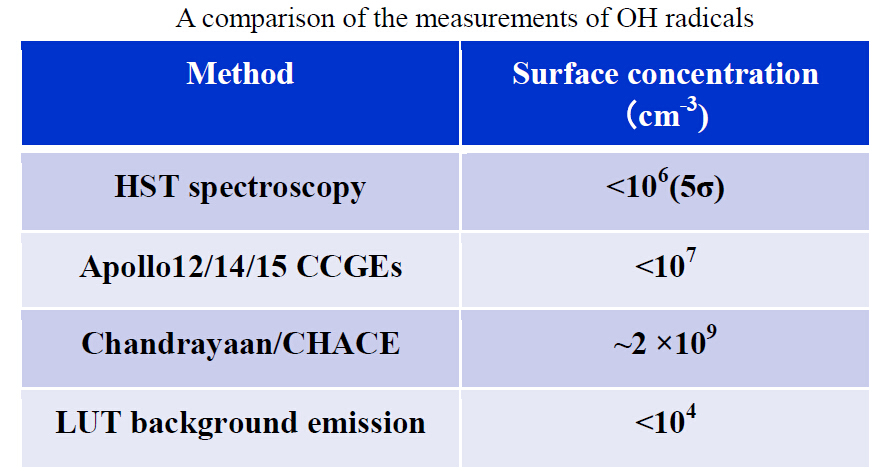Through the observations carried out by Lunar-based Ultraviolet Telescope (LUT), the group of LUT in National Astronomical Observatories (NAOC), CAS, recently reported a new upper limit of the water (OH radical) content within lunar exosphere, with the support from the ground system of CE-3 mission. The columndensity is <1011cm-2,and the concentration <104cm-3, which is the best known in this field in the mankind history. These new results have been recently accepted by Planetary and Space Science. The inferred concentration, which is roughly consistent with the prediction of the sputtering model, is about 100 times lower than that obtained by Hubble Space Telescope spectroscopy, and disproves the results recently given by the Chandrayann/CHACE developed by Indian and NASA (see table below).

The Moon has an extremely tenuous atmosphere (the so-called exosphere). A commonly accepted scenario is that the exosphere comes from the rocket through micro-metor impact, photonstimulated desorption and sputtering by the high energy protons in the solarwind. The content and distribution of the exosphere is now rather poorlyunderstood because of its extremely low density.
Water attracts most attention because it is important not only for planetary evolution, but also for the existence of life. Both Moon Mineralogy Mapper (M^3), a NASA instrument onboardthe Chandrayaan-1, and Visual and Infrared Mapping Spectrometer (VIMS) on the Cassini recently discovered a wide distribution of water on the sunlitside of the Moon through the broadspectral absorption features in infrared. These adsorbed water molecules could be released to the exosphere through the aforementioned processes. However, all the available measurements are higher than that theoretically predicted by an order of magnitude of 2-6.
The sunshined OH radicals has an resonant emission at 3087A, which is covered by the bandpass of LUT. This coverage enables us to infer the water content in the exosphere from the sky background in the images taken by LUT. After excluding the contribution from the zodiacal light, we obtained the unprecedentedupper limit of the water content within the exosphere by assuming sky background is fully contributed by the resonant emission from OH radicals (The contribution due to stray light can not be separated from the images). In addition to the OH radicals, an unprecedentedupper limit of the content of natural magnesium is inferred to be about 100 times lower than the previous reports through the same method.

Address: 20A Datun Road, Chaoyang District, Beijing, China code: 100012
Tel: 010-64888708 E-mail: naoc@nao.cas.cn

